How to Switch from Blogger to WordPress without Losing Google Rankin
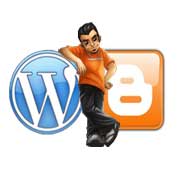
Blogger is an awesome free tool to quickly
start blogging. However, many Blogger users quickly realize that if
they need full control of their blog, they would be better off with
their own self hosted WordPress.org blog (What’s the difference between self-hosted WordPress.org vs WordPress.com blogs). In this step by step tutorial we will help you switch from Blogger to WordPress without losing Google rankings.
To get started with WordPress, the first thing you would need is a WordPress hosting service provider and your own domain name. We have hand-picked a list of WordPress hosting providers that we have used for our own projects. These web hosts offer special deals and discounts to WPBeginner readers and most of them offer a free domain name upon signup.
Once you have signed up for WordPress hosting and set up your domain name. The next step is to install WordPress on your new website. We have a step by step tutorial on how to install WordPress. Once you have installed WordPress, it is time to import your content from Blogger to WordPress.
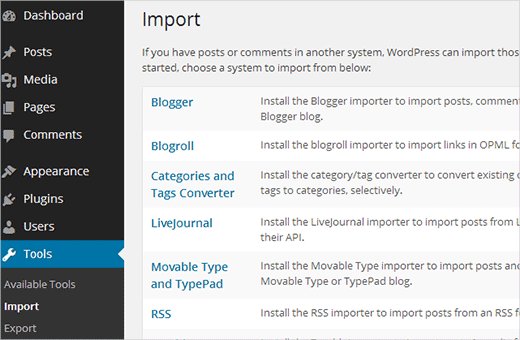
This will bring up a popup, asking you to install blogger importer. Click on the Insall button and WordPress will now download and install Blogger Importer plugin for you. Once it is finished installing the plugin you need to click on Activate Plugin and Run Impoter link to continue.
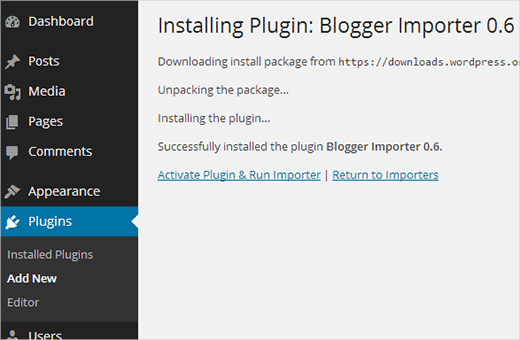
On the next screen, you will be asked to authorize WordPress to import your Blogger blog. You need to click on the Authorize button on this page, which will take you to your Google Accounts page. On your Google Accounts page, you will be notified that the application WordPress is requesting permission to manage your Blogger account. You need to click on the Allow Access button to continue.
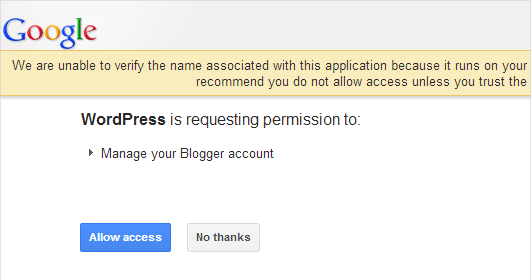
You will be now redirected back to WordPress where you will see the list of your Blogger blogs. All you need to do is click on the import button next to the blog you want to import.

WordPress will now import your blogger posts from blogger, once it is finished you will be asked to assign an author to the imported posts. You can assign your blogger posts to an existing author.
Congratulations! you have successfully imported your Blogger blog into WordPress. However, you still need to make sure that you don’t loose any search rankings and that visitors to your old blog easily land to the same content on your new WordPress powered website.

To do this you need to set up redirection on two levels. First you will redirect Blogger visitors to your new WordPress blog. Secondly, once users reach your WordPress site you will redirect them to exact post they were accessing on your Blogger blog.
Let’s first set up redirection on the blogger blog. To do that you need to log on to your Blogger account and go to your Blog’s settings and click on Template.

On the template page, you need to scroll down to the bottom of the page and click on Revert to Classic Template link.

After switching to classic template, you will see ‘Edit Template HTML’ text area. You need to replace every thing in this text area with the following code. Make sure that you replace
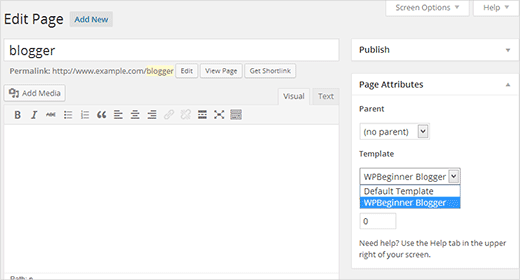
That’s all you needed to do. Now anyone visiting a post on your old Blogger blog will be redirected to the same post on your new WordPress site.
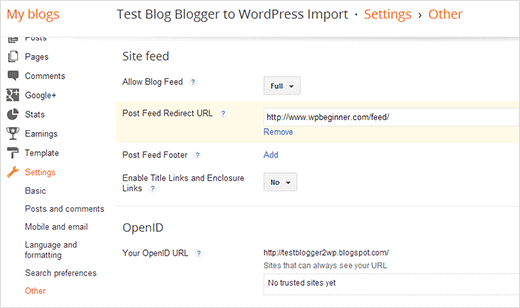
We hope this tutorial helped you switch from Blogger to WordPress without losing Google rankings. We would like to welcome you to the WordPress community. To get started with WordPress, please take a look at our beginner’s guide section for more WordPress tutorials. For questions and feedback, please leave a comment below.
To get started with WordPress, the first thing you would need is a WordPress hosting service provider and your own domain name. We have hand-picked a list of WordPress hosting providers that we have used for our own projects. These web hosts offer special deals and discounts to WPBeginner readers and most of them offer a free domain name upon signup.
Once you have signed up for WordPress hosting and set up your domain name. The next step is to install WordPress on your new website. We have a step by step tutorial on how to install WordPress. Once you have installed WordPress, it is time to import your content from Blogger to WordPress.
Step 1. Import Your Blogger Blog into WordPress
To import your Blogger blog into WordPress, you need to go to Tools » Import and click on Blogger.
This will bring up a popup, asking you to install blogger importer. Click on the Insall button and WordPress will now download and install Blogger Importer plugin for you. Once it is finished installing the plugin you need to click on Activate Plugin and Run Impoter link to continue.

On the next screen, you will be asked to authorize WordPress to import your Blogger blog. You need to click on the Authorize button on this page, which will take you to your Google Accounts page. On your Google Accounts page, you will be notified that the application WordPress is requesting permission to manage your Blogger account. You need to click on the Allow Access button to continue.

You will be now redirected back to WordPress where you will see the list of your Blogger blogs. All you need to do is click on the import button next to the blog you want to import.

WordPress will now import your blogger posts from blogger, once it is finished you will be asked to assign an author to the imported posts. You can assign your blogger posts to an existing author.
Congratulations! you have successfully imported your Blogger blog into WordPress. However, you still need to make sure that you don’t loose any search rankings and that visitors to your old blog easily land to the same content on your new WordPress powered website.
Step 2. Setting up Permalinks
Permalinks is the term used for URL structure of permanent links for individual entries in blogs. WordPress comes with a feature that allows you to set up SEO friendly URL structure. However, since you are importing content from Blogger you would want your URL structure to be as close to your Blogger URL structure as possible. To set permalinks you need to go to Settings » Permalinks screen and choose Month and Name as your permalink structure.
Step 3. Setting up Redirection
The most important step in moving any website is to set up redirection so that users are redirected to your new website. The crucial part of redirection is that you would want users to land on exactly the same page on the new site which they were accessing on the old site. Secondly, you would also want search engines to notice that your old site is moved to this new location.To do this you need to set up redirection on two levels. First you will redirect Blogger visitors to your new WordPress blog. Secondly, once users reach your WordPress site you will redirect them to exact post they were accessing on your Blogger blog.
Let’s first set up redirection on the blogger blog. To do that you need to log on to your Blogger account and go to your Blog’s settings and click on Template.

On the template page, you need to scroll down to the bottom of the page and click on Revert to Classic Template link.

After switching to classic template, you will see ‘Edit Template HTML’ text area. You need to replace every thing in this text area with the following code. Make sure that you replace
http://www.example.com with your own domain name. <!DOCTYPE html PUBLIC "-//W3C//DTD XHTML 1.0 Strict//EN" "http://www.w3.org/TR/xhtml1/DTD/xhtml1-strict.dtd"> <html xmlns="http://www.w3.org/1999/xhtml" xml:lang="en" lang="en" dir="<$BlogLanguageDirection$>"> <head> <title><$BlogPageTitle$></title> <script type="text/javascript"> <MainOrArchivePage> window.location.href='http://www.example.com/' </MainOrArchivePage> <Blogger><ItemPage> window.location.href='http://www.example.com/blogger/?q=<$BlogItemPermalinkURL$>' </ItemPage></Blogger> </script> <MainPage><link rel="canonical" href="http://www.example.com/" /></MainPage> <Blogger><ItemPage> <link rel="canonical" href="http://www.example.com/<$BlogItemPermalinkURL$>" /> </ItemPage></Blogger> </head><body> <div style="border:#ccc 1px solid; background:#eee; padding:20px; margin:80px;"> <p>This page has moved to a new address.</p> <h1> <MainOrArchivePage><a href="http://www.example.com"><$BlogTitle$></a></MainOrArchivePage> <Blogger><ItemPage> <a href="http://www.example.com/<$BlogItemPermalinkURL$>"><$BlogItemTitle$></a> </ItemPage></Blogger> </h1> </div> </body></html> <!-- replace example.com with your WordPress site URL --->Save your template, and you have successfully implemented redirection on your Blogger blog. However, you still need to setup your redirection on your WordPress site so that users are redirected to the proper posts. To do that, you need to create a new file using a plain text editor like Notepad. Give this file a name like
wpb-blogger.php and paste this code inside it. <?php
/*
Template Name: WPBeginner Blogger
*/
global $wpdb;
$old_url = $_GET['q'];
if ($old_url != "") {
// Fix for blogger blogs with .de and other tlds in their URLs
$tld_fix = preg_replace("/blogspot.[a-zA-Z0-9]+/", "blogspot.com", $old_url);
$permalink = explode("blogspot.com", $tld_fix);
$q = "SELECT guid FROM $wpdb->posts LEFT JOIN $wpdb->postmeta ".
"ON ($wpdb->posts.ID = $wpdb->postmeta.post_id) WHERE ".
"$wpdb->postmeta.meta_key='blogger_permalink' AND ".
"$wpdb->postmeta.meta_value='$permalink[1]'";
$new_url = $wpdb->get_var($q)? $wpdb->get_var($q) : "/";
header ("HTTP/1.1 301 Moved Permanently");
header("Location: $new_url");
}
?>
Save your changes and upload this file to your WordPress theme directory using an FTP client.
Once you have uploaded the file to your theme directory go to your
WordPress admin area and create a new page in WordPress. In the title
field for this page enter blogger. Under the Page Attributes section choose WPBeginner Blogger as template and click on the Publish button. 
That’s all you needed to do. Now anyone visiting a post on your old Blogger blog will be redirected to the same post on your new WordPress site.
Step 4. Redirect Feeds
On your old blogger site, your feed subscribers will not be able to notice the switch. So it would be best to redirect your blogger feed to your new WordPress site’s feed as well. To do that, you need to go to your Blogger account. Go to the Settings » Other and under the Site Feed section click on Add link next to Post Feed Redirect URL. Here you can enter your new WordPress site’s feed address.
Step 5. Import Images From Blogger to WordPress Media Library
During the import, your Blogger posts may still have images embedded which are still hosted on the blogger platform. You can import these images into your WordPress site. Follow the instructions in our how to import external images in WordPress tutorial, this will import all images from your blogger blog into your WordPress Media Library. Once the images are in your WordPress media library you can create image galleries and use other WordPress image related plugins with your imported images.We hope this tutorial helped you switch from Blogger to WordPress without losing Google rankings. We would like to welcome you to the WordPress community. To get started with WordPress, please take a look at our beginner’s guide section for more WordPress tutorials. For questions and feedback, please leave a comment below.





Such an exceptionally valuable article. Extremely intriguing to peruse this article. I might want to thank you for the endeavors you had made for
ReplyDeletecomposing this amazing article.
WordPress Bundle,
WordPress Bundle Pack,
WordPress Starter Pack,
WP Starter Pack,
WP Bundle Pack,
Giant Brand Solutions,
Premium WordPress Themes and Plugins,
WordPress Themes,
WordPress Plugins,